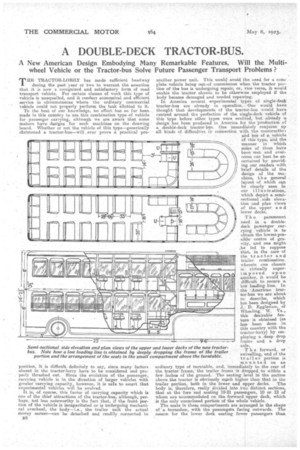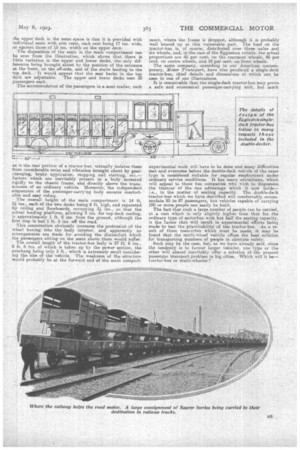A DOUBLE-DECK TRACTOR-BUS.
Page 10

Page 11

If you've noticed an error in this article please click here to report it so we can fix it.
THE TRACTOR-LORRY has made sufficient headway during the past year or two to warrant the assertion that it is now a recognized and satisfactory form of road transport vehicle. For certain classes of work this type of vehicle is unequalled, and it renders economical and efficient service in circumstances where the ordinary commercial vehicle could not properly perform the task allotted to it. To the best of our knowledge, no effort has 80 far been made in this country to use this combination type of vehicle for passenger carrying, although we are aware that some makers have designs for such machines on the drawing board. Whether or not the vehicle of this type—generically christened a tractor-bus—will _ever prove a practical pro
position, it is difficult definitely to say, since many factors absent in the tractor-lorry have to be considered and properly thrashed out. Since the evolution of the passenger, carrying vehicle is in the direction of larger vehicles with greater carrying capacity, however, it is safe to assert that experimental vehicles will be evolved.
It is, of course, this factor of carrying capacity which is one of the chief attractions of the tractor-bus, although, perhaps, not less noteworthy is the fact that, if the front portion of the vehicle is incapacitated or i8 undergoing mechanical overhaul, the body—i.e., the trailer unit the actual money earner—can be detached and readily connected to
B8 another power unit. This would avoid the need for a complete vehicle being outeof commission when the tractor portion of the bus is undergoing repair, or, vice versa, it would enable the tractor chassis to be otherwise employed if the body became damaged and needed repairing, In America several experimental types of single-dee*
tractor-bus are already in operation. One would have thought that developments of the tractor-bus would have centred around the perfection of the single-deck vehicle Of this type before other types were evolved, but already a design has been produced in America for the 'production of a double-deck tractor-bus. One immediately conjures. up all kinds of difficulties in connection with the constructioi and -use. of • a..v.ehicle if this type, and the manner in which some of them have been met and overt come can best be ascertained by providing our readers with brief details of the design of the ma-. chine, the general layout of which can be clearly seen in our illustrations, which depict a semisectional .side clovetion • and plan views of the upper a n d lower decks.
T h a paramount need in a doubledeck passenger carrying vehicle is to obtain the lowest Pos
sible of gravity, and one might ,be led to suppose that, in the case of the tractor and trailer combination. wherein one chassis is virtually superimposed upon another, it would be difficult to secure a low loading line. In the American tractor-bus we are about to describe, which has been designed by J. D. Eggleston, of • Wheeling. W. Va., this desirable featare is obtained • (as has. been done in this country with the tractor-lorry) by employing a .deep drop ordinary type of turntable, and, immediately to the rear of the tractor frame, • the trailer frame is dropped to within a few inches of the ground. The 'seating level the section above the tractor is obviously mach higher than that in the trailer portion, both in the lower and upper decks. The body is, therefore, really divided into two distinct sections, that at the 'fore end seating 19-21 passengers, 10 or, 12 of whom are accommodated on the. forward upper deck, which is the only tmenclosed portion of the whole vehicle.
The seats in these compartments are arranged in the shape of a horseshoe, with the passengers facing outwards. The reason for the lower deck seating fewer passengers than
the upper deck in the same space is that it is provided with individual seats with arm rests, each seat being 17 ins. wide, as against those of 15 ins, width on the upper deck.
The disposition-of the seats in the main compartment can be seen from the illustration, which Sh011745 that there is little variation in the upper and lower decks, the only differences being brought about by the position of the entrance at the front, on the off-side, and of the stairs leading to the top deck. It would appear that the seat backs in the top deck are adjustable. The upper and lower decks seat 35 passengers each.
The accommodation of the passengers in a semi trailer, such
as is the rear portion of a tractor-bus, virtually isolates them from considerable noi,se and vibration brought about by gear. changing, brake application, stopping and starting, etc.— factors which are inevitably present in a body mounted' ri.gidly to the chassis frame, and directly above the transmission of an ordinary vehicle. Moreover, the independent suspension of the passenger-carrying body ensures comfortable and easy riding. The overall height of the main compartmentis 14 ft. ins., each of the two decks being 6 ft. high, and separatedby ceiling and floorboards, occupying 3 ins., so that the actual loading platform, allowing 3 ins, for top-deck roofing, is approximately 1 ft. 8 ins. from the ground, although the first step is but 1 ft. 2 ins. off the road.
This construction obviously increases the protrusion of the wheel boxing into the body interior, and apparently no arrangements are made for avoiding the discomfort which the passengers sitting on the seats above them .would suffer. The overall lerVh of the tractor-bus body is 37 ft, 6 ins., 9 ft. 6 ins, of which is taken up by the power section, the overhang being only 5 ft.: which is extremely small considering the size of the vehicle. The weakness of the structure would probably be at the forward end of the main compart
ment, where the frame is dropped, although it is probably well braced up at this vulnerable part. The load on the tractor-bus is, of course, distributed over three axles and six wheels, and, in the case of the Eggleston vehicle, the actual proportions are 45 per cent, on the rearmost. wheels, 45 per cent. on centre wheels, and 10 per cent. on front wheels.
The same company, according to • our American contemporary, Motor Transport, have also produced a single-deck tractor-bus, chief details and dimens:ons of which can be seen in one of our illustrations.
It is conceivable that the single-deck tractor-bus may prove a safe and economical passenger-carrying unit, but much experimental work will have to be done and many difficulties met and overcome before the double-deck vehicle of the same type is considered suitable for regular employment under ordinary service conditions. It has many attractions, which will appeal to those bus cOmpanies who wish to dispossess the tramcar of the one advantage which it now holdsi.e., in the matter of seating capacity. The double-deck tractor-bus which we have described will comfortably. accoinmodate 85 to,87 passengers, but vehicles capable of carrying 100 or more people can easily be built.
The fact that such a large number of people can be carried, at a cost which is only slightly higher than that for the ordinary type of motorbus with but half the seating capacity, is the factor that will result in experimental efforts being made to test the practicability of the tractor-bus. As a result of these researches which most be made it may be found that the multi-wheel vehicle offers the best solution for transporting numbers of people in absolute safety.
Such may be the case, but, as we have already said, since the tendency is to favour larger vehicles, one type or the other will almost inevitably offer a solution of the present passenger transport problem in big cities. Which will it betractor-bus or multi-wheeler?


































